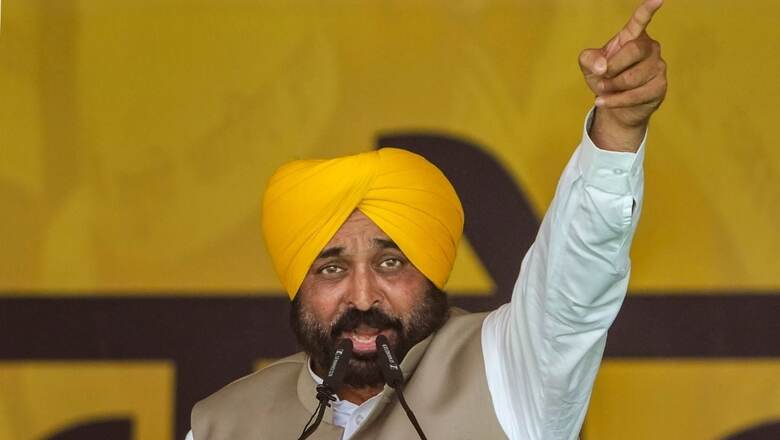
views
To give impetus to the industrial growth in Punjab, Chief Minister Bhagwant Mann recently released WhatsApp number 8194891948 and e-mail ID [email protected] to solicit feedback from stakeholders, which is an appreciable initiative. It is a formal platform on which industrialists can voice their grievances and suggestions, which can be forwarded to the concerned officials and accountability can be brought with the delivery of services, schemes and policies. At the same time, this mechanism may help the Chief Minister’s Office (CMO) and the downstream team to better understand the issues of the industry so that they can be resolved promptly.
To match the objective of this initiative and to provide an accessible, transparent, robust, effective, accountable and time-bound grievance redressal system for industries in Punjab, there is a need to formulate a comprehensive “Industry’s Grievance Redressal Policy” to connect a sustainable solution.
In 2013, the previous government had also adopted the ‘PBGrams’ portal but the grievances were not handled promptly, with transparency and accountability. Now, the chief minister’s intent is very clear — to bolster the industrial growth of Punjab. To carry forward the state on the high trajectory of growth and prosperity, it is hoped that the bureaucratic setup of the industry department and others will have to back CM’s intent. The officials have to make sure that the industry’s issues are not to be filed and dumped before any logical conclusion. The complainant should also be informed of the redressal via the same interface taken for the registration of the grievance.
Efficient and Effective Setup Needed
The stakeholders know the strengths and weaknesses of their ecosystem better and can explore the upcoming opportunities and prompt the desirable Punjab landscape as a global manufacturing and export destination. Therefore, government officials can exhort valuable suggestions from the stakeholders. The data and the details of the feedback could be analysed with Artificial Intelligence (AI) to help identify duplicate, dubious or bogus grievances so that the government can spend time and effort towards genuine concerns of the stakeholders.
Comprehensive data analysis of the collected feedback and grievances prepares a data visual based on geography, the nature of grievances and sector-wise industry indicators. This aggregate data, represented through different variables, will better inform the state government to make crucial policy decisions related to the industry. It will be very helpful while framing new policies or upgrading the existing ones. It would be a milestone to put Punjab on a high trajectory of governance reform. Finally, we must adhere to appropriate standards, best practices and effective governance needed to spur the industry’s growth.
Punjab has certain disadvantages and despite that, the entrepreneurial spirit of Punjabis is recognised as an ‘achiever’ among the landlocked states. Still, its key manufacturing industries like auto parts, farm equipment and tractors, bicycles, yarn-textiles engineering goods etc. have strong potential to foster growth.
Along with bringing new industrial investments into the state, the Punjab government has to provide a hassle-free atmosphere to the existing industrial units so that they can expand their operations within the state. The erosion of industry is one of the major crises facing Punjab. At a time when the Central government is attempting to project India as a manufacturing destination, why are Punjab’s leading industrial clusters going stagnant rather than growing? Punjab registered a 3.6 percent CAGR (Compound Annual Growth Rate) in the industrial sector in the last five fiscal years (2017-18 to 2022-23) while neighbouring state Haryana registered 5.9 percent, and the national average growth rate was 5.63 percent.
The Punjab industry needs only a conducive and supportive environment. Still, the industry department and other officials adopted a lackadaisical approach towards the industry. There are a couple of issues like complex rider for exporters to avail 2.5 percent SGST refund. In this context, three years back, a circular was notified but execution on the ground is nil. Even though this is one of the major grievances, there may be a lot of grievances of the stakeholders in recent times shared on the CM’s WhatsApp number and email IDs. The officials dealing with the grievances and feedback coming on these platforms should be more attentive and focused if they want the CM’s dream to come true.
The Way Forward
To create a conducive atmosphere, Bhagwant Mann intends to use Information Technology (IT) as an important tool to make the industry’s grievance redressal ecosystem equitable, de-centralised, transparent, accountable, inclusive, and accessible. Finally, the ‘Industry’s Grievance Redressal Policy’ is needed to provide a dedicated standardized single platform. With the help of this policy, states will be able to create a multi-stakeholder ecosystem of efficient, accountable and transparent governance.
Face-to-face meetings should also be held with all stakeholders to evaluate the impact, effectiveness, efficiency, accessibility and transparency of the grievance resolution process.
Overall, many investment opportunities have great potential to be nurtured with a supportive environment that could further transform the industrial sector as a job engine to make a ‘Vibrant Punjab’.
The author is Vice-Chairman of Sonalika group, Vice-Chairman (Cabinet minister rank) of Punjab Economic Policy and Planning Board. Views expressed in the above piece are personal and solely that of the author. They do not necessarily reflect News18’s views.




















Comments
0 comment